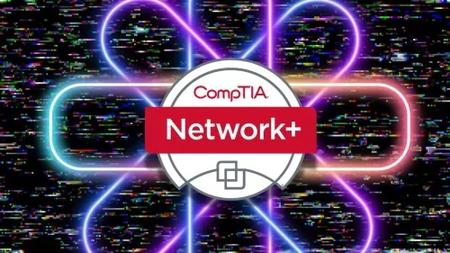English | MP4 | AVC 1920×1080 | AAC 44KHz 2ch | 96 Lessons (8h 40m) | 3.08 GB
Go from complete beginner to passing the CompTIA Network+ certification exam. You’ll learn networking fundamentals, the latest best practices, and everything you need to know to pass the exam so that you can launch your Networking and IT career. No previous knowledge required.
The most efficient and up-to-date CompTIA Network+ Bootcamp course that you can find, guaranteed. You’ll learn networking best practices and exactly what is needed to ace the certification so that you can get hired as a Systems Administrator, Security Administrator, Security Engineer, IT Specialist, and more!
WHAT YOU’LL LEARN
- Learn the basic concepts of networking, including the OSI model, network types, topologies, and essential networking terminology.
- Gain knowledge about various networking cables, their characteristics, uses, and standards, including copper and fiber cables.
- Understand IP addresses, the differences between IPv4 and IPv6, public and private IPs, and master the critical skill of subnetting.
- Explore different WAN technologies and methods for remote communication across wide-area networks.
- Learn about the most common network protocols and their associated ports essential for application communication.
- Dive deep into essential networking protocols such as DNS, DHCP, and NTP, understanding their functions and importance.
- Study data center and corporate network architectures, including Three Tier and Spine-Leaf Architecture, and explore cloud concepts, deployment models, and connectivity options.
- Learn about network operations, documentation, procedures, and security measures to protect against network threats, and how to troubleshoot common network issues.
Table of Contents
1 The Networking Bootcamp (CompTIA Network+ Certification) Zero to
2 Course Introduction
3 What is Networking
4 Open Systems Interconnection (OSI) Model
5 Encapsulation and Decapsulation
6 Network Topologies
7 Network Types and Characteristics
8 Service Related Entry Point
9 Virtual Network Concepts
10 Provider Links
11 Copper
12 Fiber
13 Connector Types
14 Cable Management
15 Ethernet Standards
16 Internet Protocol Version 4 (IPv4) Explained
17 Internet Protocol Version 6 (IPv6) Explained
18 IPv4 vs. IPv6
19 Subnetting
20 Network Address Translation (NAT)
21 Wide-Area Network (WAN) Technologies – Part 1
22 WAN Technologies – Part 2
23 Remote Access
24 WAN Troubleshooting
25 IP Protocol Types
26 What are Ports_
27 File Transfer Protocol (FTP), SSH File Transfer Protocol (SFTP), Telnet, Secure Shell (SSH)
28 Simple Mail Transfer Protocol (SMTP), Post Office Protocol 3 (POP3), Internet Message Access Protocol Version 4 (IMAP4)
29 Domain Name System (DNS), Dynamic Host Configuration Protocol (DHCP), Simple Network Management Protocol (SNMP)
30 Hypertext Transfer Protocol (HTTP), HTTPS (Secure)
31 Server Message Block (SMB), Lightweight Directory Access Protocol (LDAP), Network Time Protocol (NTP), Syslog
32 MySQL, SQLNet
33 Remote Desktop Protocol (RDP), Session Initiation Protocol (SIP)
34 Dynamic Host Configuration Protocol (DHCP)
35 Domain Name System (DNS)
36 Network Time Protocol (NTP)
37 Three Tier
38 Software Defined Network (SDN)
39 Spine and Leaf
40 Traffic Flows
41 Branch Office vs. On Premise vs. Colocation
42 Storage Area Network (SAN)
43 Exercise Imposter Syndrome
44 Deployment Models
45 Service Models
46 Connectivity Options
47 Pros and Cons of Cloud
48 Networking Devices
49 Networked Devices
50 Routing
51 Virtual Local Area Network (VLAN)
52 Port Configuration
53 MAC Address
54 Power Over Ethernet (PoE), PoE+ (Plus), Spanning Tree Protocol (STP), Carrier Sense Multiple Access (CSMA
55 Address Resolution Protocol (ARP)
56 Neighbour Discovery Protocol (NDP)
57 IEEE 802.11 Standards
58 Frequencies and Range
59 Channel and Channel Bonding
60 Service Set Identifier (SSID)
61 Antenna Types
62 Wireless Encryption
63 Wireless Authentication Protocols
64 Performance Metrics
65 Simple Network Management Protocol (SNMP)
66 Network Device Logs
67 Interface Status
68 Environmental Factors
69 Plans and Procedures
70 Hardening and Security Policies
71 Common Documentation
72 Common Agreements
73 Load Balancing, Multipathing and Network Interface Cards (NIC) Teaming
74 Redundant Hardware and Clusters
75 Redundancy and High Availability (HA) Concepts
76 Confidentiality, Integrity and Availability (CIA) Triangle and Security Basics
77 Threats and Vulnerabilities
78 Defense
79 Authentication, Authorization and Accounting (AAA) Servers
80 Types of Authentication and Authentication Management
81 Existing Authentication and Authorization Mechanisms
82 Risk Management
83 Security Information and Event Management (SIEM)
84 Technology Based Attacks
85 Social Engineering
86 Network Hardening
87 Wireless Hardening Techniques
88 Importance of Physical Security
89 Establish a Theory of Probable Cause
90 Identify the Problem
91 Cable Connectivity Issues
92 Common Tools Used for Connectivity Issues
93 Software Tools
94 Common Wireless Connectivity Issues
95 General Networking Issues
96 Thank You!
Resolve the captcha to access the links!
